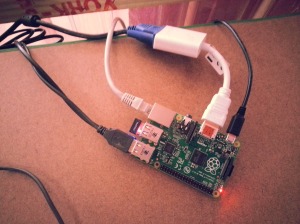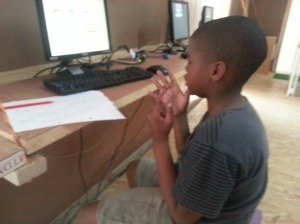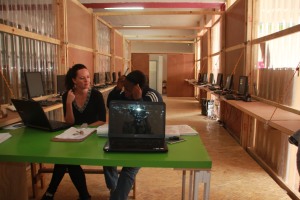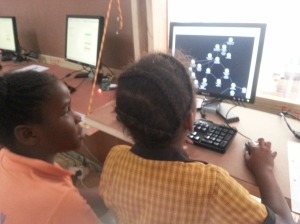This is how we set up a computer lab for less than R1000/$86 a unit, using free high-quality software that learners love.
1.) What’s a Raspberry Pi?
A Raspberry Pi is a small, inexpensive credit-card sized computer that was developed by the Raspberry Pi Foundation. One of their goals was to make computing accessible to advance the education of adults and children, particularly in the fields of computing and computer science.
Because the Pi is intended to be cost-effective, it normally ships without any accessories and you may have to do the initial setup yourself.
2.) How you set up a Pi and what can you do with it?
The process of “baking” a Pi simply means to install the software it needs to run, namely the Raspbian Operating System.
The Raspberry Pi used in the lab is running a distribution of Linux especially created for the Pi called, Raspbian Wheezy. It is a derivative of the Debian linux distribution for the ARM architecture which the Pi’s processing unit uses. Khan-lite is a web based application built with Python and based of the well-known Khan Academy structure. The Pi’s have a browser which can use the Khan-lite application.
In a nutshell, Khan-lite server, Raspberry Pi client and traditional LAN network or wifi connects the two. Currently students can do any of the programs bundled with KA Lite -essentially an offline version of Khan Academy. They can also use any browser-based educational products.
Unfortunately the B+ models weren’t up to the challenge of streaming video quite yet, but we have high hopes for the model B2. The current setup also allows teachers to explore computing with students, starting from the basics, highlighting the simplest components that make up a computer – the building blocks of the modern world.
3.) What’s good about KA Lite as a learning tool?
Khan is a totally free program that works on adaptive and mastery-based learning– the idea that we should prioritise “measuring outcomes versus punching the clock”.
So, in Khan, the software adapts or learns the progression rate of a particular student and then advances them accordingly. The idea is that students move on only once they’ve mastered an idea. This means that kids go as quick or as slow as they need to, as opposed to the single pace of a classroom setting.
4.) How do you get the cost down to under R1000/$86?
There are two expensive components to hardware: the CPU (the ‘computer’ bit) and the monitor (the screen).
However, there many ways to get screens and keyboards for free as many large companies need to overhaul their computer equipment every couple of years. This means that there are warehouses of perfectly good equipment waiting to be used. Our were generously donated by the FNB Warehouse. But there are many equivalent organisations or even computer recycling companies that would be able to provide screens. In this way we were able to get monitors, keyboards and computer mice for free.
A Rasperry Pi costs R 449.00, a good power cable costs R89.00, and an 8 Gig SD card costs R149.00 which brings you to a total cost of R 687
($60). It is possible to get a Pi set-up at this cost. Unfortunately, we could only find VGA screens, and therefore had to purchase a set of HDMI to VGA converters at R310.00 bringing our total cost per Pi Computer to R997.00 ($86). All items can be purchased from http://pifactory.co.za/
Depending on whether you’re building multiple units or just one you may need to incur the cost of a local server (we used a donated PC tower) and some network cables.
5.) What do our learners think?
So far, the children have loved it so much that going to the computer lab is seen as a reward: children will perform tasks like homework faster so that they can have more time in the lab.
In the lab, we have 2 children to each computer. Pairing is a great way to have children engaged in an activity and share knowledge between themselves. By having the children pair up on tasks, we find they are usually more motivated and can bounce ideas off each other.
In the best case scenario, a less knowledgeable learner may be paired up with one that is slightly more knowledgeable, and such that the former is designated “driver”. This puts the more knowledgeable learner in a unique position to instruct, or share their knowledge and collaborate to complete the task. There may be some frustration initially, but the idea is to meet the goals collaboratively rather than competitively.
Jaco Groenewald, Chief Innovator at Comune.IT and Sett Wai, Software Developer at Thoughtworks, and Melanie Smuts, CEO Streetlight Schools.




I am delighted to read about Streetlight Schools.
I am driven by the same motivation for the children we feed, daily, and I am investigating all means of improving their education, and digital skills which I regard as being ‘literate’ in the modern world.
I request to talk to you to see how to set this up – I have funding!
Regards
Claire
LikeLike
Hi Claire,
Thank you for your message! Please send me an email at melanie@streetlightschools.org with your needs and we can help you set up a lab.
My best,
Melanie
LikeLike
Pingback: Innovative low-cost architecture: building the Education Lab for under R70, 000 ($5,960) | Streetlight Schools
Pingback: Thank you for backing us. Here’s what we did with your contribution. | Streetlight Schools